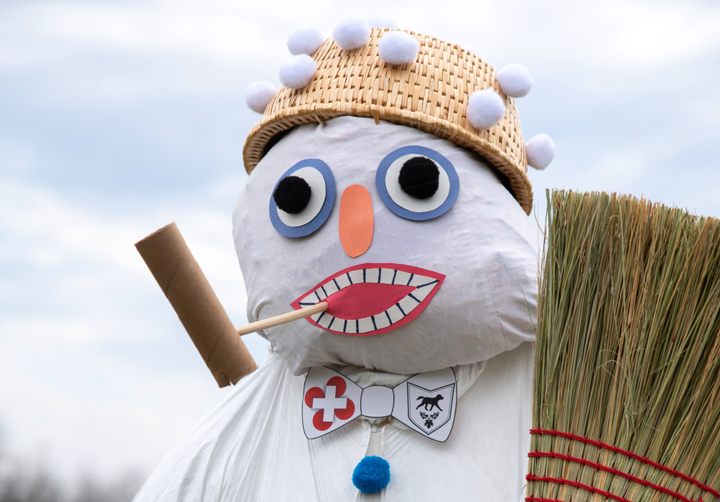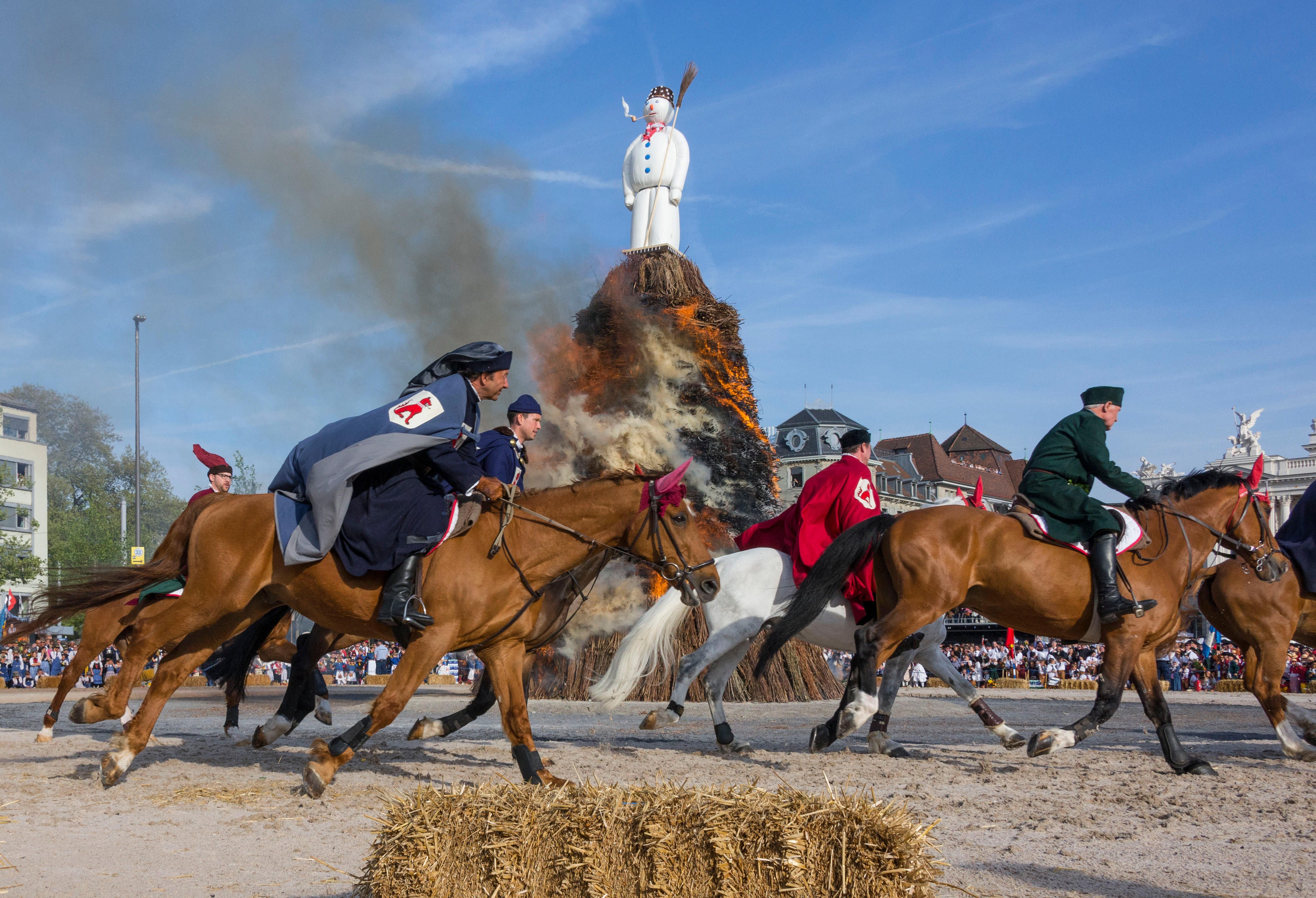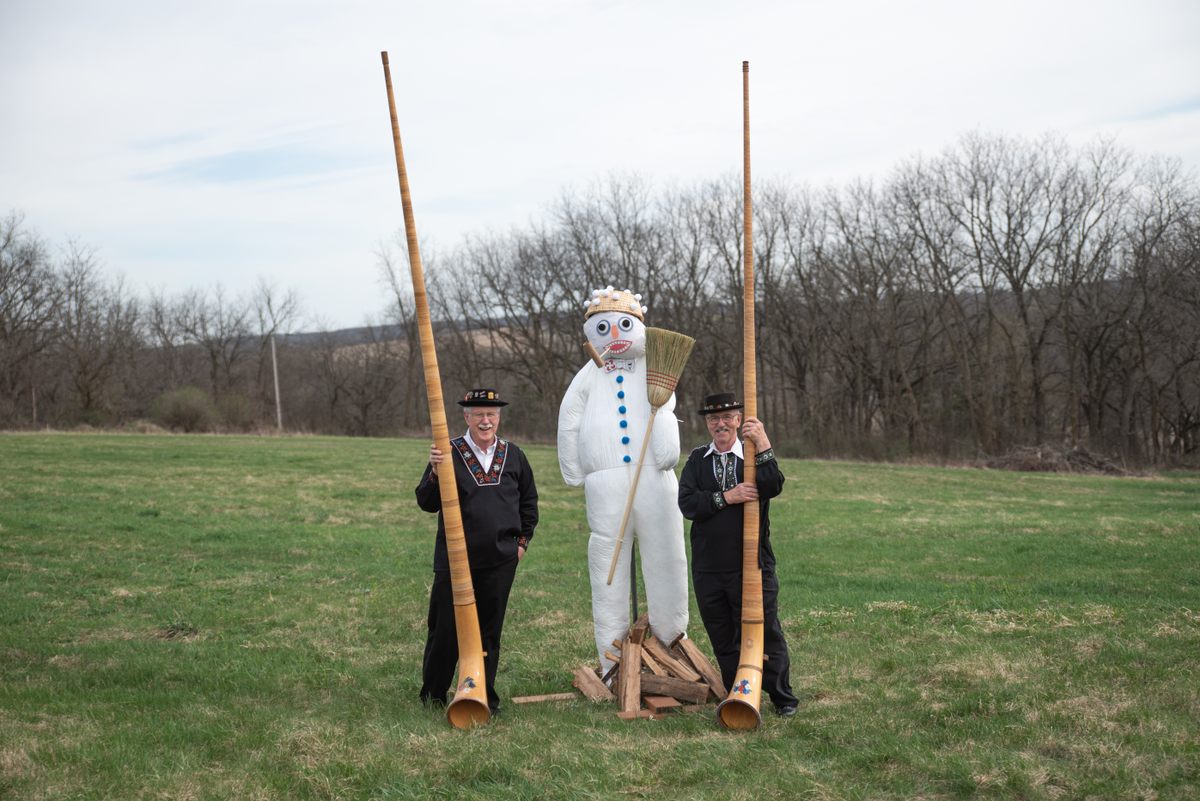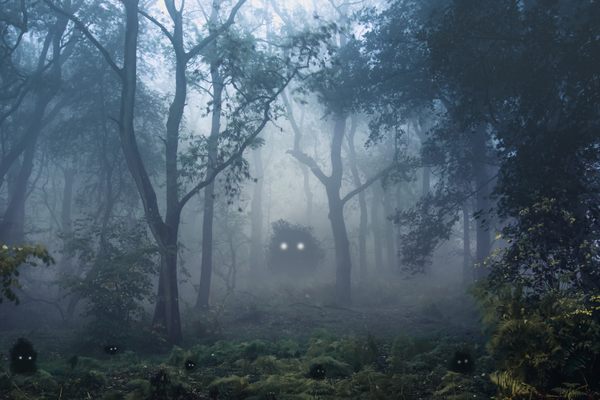
To Banish Winter in This Tiny Wisconsin Town, Burn a Swiss Snowman
The burning of the Bӧӧgg is like a fiery version of Groundhog’s Day, but with fireworks and sausages.
April 15 was an unseasonably warm day in New Glarus, Wisconsin. A 40-minute drive southwest of Madison, the state’s capital, New Glarus doesn’t look like many small towns in America. Its tiny downtown is laden with Swiss names, flags, and chalet-style architecture. Everyone in town hoped the nice weather would stay, but there was only one way to know for sure—burn a giant snowman effigy (naturally). Villagers gathered at a winery on the outskirts of town to hold the centuries-old Swiss ritual: the burning of the Bӧӧgg (pronounced BOOg). Like Groundhog’s Day, the Bӧӧgg’s fiery demise is supposed to predict the amount of cold weather left to endure. And for the first time in this small town, a Bӧӧgg is about to get lit.
Standing in an empty field down a small hill from the vineyard’s winery building, near the still bare grapevines, is the Bӧӧgg. It’s a lumpy white fabric snowman filled with hay and wedged on a metal pole with a handcrafted face cut from felt, a pipe made from a cardboard paper towel tube, and a hat fashioned out of a wicker basket. His feet are surrounded by a pile of firewood. The Bӧӧgg has a toothy grin and looks as holly jolly as can be considering it won’t be long till the effigy meets an explosive end—the five-foot-tall Bӧӧgg’s head is stuffed with fireworks.
Just before 4 p.m., Greg Long, one of the directors of the Swiss Center of North America who constructed the smiling snowman effigy, and a friend clang large cowbells—it’s almost time. Another person cracks a whip, which is meant to scare away winter spirits. Then two men in traditional Swiss garb flank the Bӧӧgg and blast a mournful tune through a pair of 12-foot-long alphorns. A crowd of about 30 people gather in the field, while dozens more watch from the winery’s patio on top of the hill, most enjoying a glass of wine or a beer. Long and his friends kneel and use a utility lighter to ignite the firewood at the Bӧӧgg’s feet. The crowd murmurs in anticipation as smoke begins to billow.

In Zurich, Switzerland’s largest city, the Bӧӧgg burning is part of Sechselӓuten, which translates to the “six o’clock ringing of the bells.” The celebration dates back to at least 1525, though the Bӧӧgg has likely deeper roots in pagan rituals once used to banish winter. Sechselӓuten was a forerunner to daylight savings, marking the end of the workday as 6 p.m. instead of five, and is celebrated on the third Monday in April. Zurich’s guilds have always organized the festival, some of which date back to 1336, such as the Zunft zur Schmiden, a guild of blacksmiths, and Zunft zum Widder, the Guild of the Ram, which represents butchers and livestock dealers.
In 1871, a guild governing body, the Zentralkomitee der Zünfte Zürichs (or ZZZ, the Central Committee of the Zurich Guilds), was formed. Elisabeth Abgottspon, curator and director of Ortsmuseum Küsnacht, a Swiss cultural museum, explains that the ZZZ still organizes Sechselӓuten, but “since the 1840s, the guilds have ceased to be trade-specific associations.” Their main function these days is “the organization of the Sechseläuten and the cultivation of social life and its traditions,” as well as maintaining their historic guild houses.

Initially, the Bӧӧgg burning was an unofficial part of Sechselӓuten, with reports of random acts of people burning straw effigies recorded at the end of the 17th century.
“The burning of straw dolls and the dance around the fire was originally a celebration of male youth that took place in various districts of Zurich,” Abgottspon says. A report from 1820 describes “cheerful and lively youngsters setting fires to woodpiles and scarecrows on the trenches [city fortifications] and neighboring hills of the city as soon as the six o’clock closing time bells rang,” according to a visitor’s guide titled “Sechseläuten in Zurich,” published by the ZZZ. The guide also notes that the name “Bӧӧgg” means a “disguised, hooded figure,” like a bogeyman, but the term also probably refers to a Zurich mandate that forbade “bӧӧggen und butzenwerk,” or “the burning of fires and boisterous celebrations.” In the 1890s, the Bӧӧgg switched from street-burning anarchy to an organized, official part of the Sechseläuten celebration.

The Bӧӧgg’s annual path to doom begins on Sunday of Sechseläuten weekend, with the Kinderumzug, a children’s parade, where about two thousand children march in traditional costumes. The Böögg brings up the tail end of the parade, pulled in a horse-drawn cart, flanked by guild members dressed as medieval executioners. The parade ends at Sechseläutenplatz, a large town square located near the east shore of Lake Zurich. The Bӧӧgg is then hoisted up on a 30-foot-high pyre, staring in the direction of Zurich’s oldest church, St. Peter’s, waiting for the bell to toll six the next day.
On Monday morning, there’s a 21-gun salute. Then members of the bakers guild, Zunft zur Weggen, throw bread rolls to onlookers, and many guilds host a special lunch. At 3 p.m., the Procession of Guilds begins, featuring about seven thousand guild members and guests. Many dress in elaborate historic costumes in styles from the 1300s up through the 1700s. Certain members proudly carry their guild banners. At 6 p.m. sharp, the pyre underneath the massive Bӧӧgg is lit, which is almost double the height of the New Glarus Bӧӧgg. Guild members then ride around the burning effigy on horseback. After anywhere from five to 45 minutes, the Bӧӧgg’s explosive-filled head detonates and fireworks rain down on the crowd.
Abgottspon says the burning is a “weather yardstick” predicting what’s to come. Five to 12 minutes is seen as a quick burn time. The longer the flames last beyond that, the worse the cold will drag on. After the Bӧӧgg’s head has blown off, the attendees take advantage of the glowing embers by having a massive sausage grill-out.

Back in New Glarus, things aren’t looking good. A steady wind is making it hard for the flames to ignite. The fire slowly creeps up the Bӧӧgg’s left leg, then the right. The torso erupts quickly, but things stall at the head. Finally, there’s a crackle and pop as the flames reach the stash of fireworks in the Bӧӧgg’s cranium. The official burn time is 32 minutes and 32 seconds, a prediction that winter will drag on in Wisconsin. The crowd slowly filters back into the vineyard’s winery, where polka records are being spun by DJ Shotski.
The Bӧӧgg burning celebration in New Glarus is on a much smaller scale than Zurich’s. But for a first-year event, it had a decent attendance of out-of-town tourists and raised money for the Swiss Center. Encouraged by the interest, Long says the event will return next year. He hopes it’ll continue to boost the Center’s mission to preserve Swiss culture.
“I love yodeling and alphorns, but there’s so much more to celebrate,” Long says. In addition to organizing events, Long plays stand-up bass for D’Schwiizer Gruppe, a traditional Swiss band (they performed in the winery before the Bӧӧgg burning). He yodels with the New Glarus Jodlerklub, and is part of a Swiss choir and a card-playing club.

“By observing these Swiss traditions, it gives us a shared starting point for building and celebrating our community,” Long says. “Even non-Swiss in New Glarus enjoy being integral parts of our [Swiss] community festivals.” When people feel removed from each other, participating in community events is “healthy, both socially and emotionally.”
New Glarus, as Beth Zurbuchen, president and CEO of the Swiss Center, explains, is “America’s Little Switzerland.” It’s the town’s slogan and is even written on the “Welcome to New Glarus” signs that greet visitors driving into town. 193 Swiss immigrants from the canton (a state-like region) of Glarus in Switzerland founded the village in 1845. Many buildings in New Glarus’ downtown feature Swiss architecture and the country’s flags and bells decorate the town’s city hall and the Glarner Stube, a 122-year-old Swiss restaurant.
The town’s long Swiss history is why the Swiss American Historical Society chose the village to house the Swiss Center of North America. Even though metropolises such as Chicago, New York, and Toronto vied for the center, New Glarus won out because of its immersive Swiss culture.


The center features a collection of material goods and archives of photographs, record books, and other documents relating to Swiss-Americans and Swiss-Canadians. Zurbuchen became president of the center in 2008. In 2016, she was honored with Swiss citizenship for her work.
Both Long and Zurbuchen agree that practicing traditions like the Bӧӧgg help preserve Swiss culture. The practice is rare here in the USA—the only other known American Bӧӧgg burns have taken place at a vineyard in Oregon and at a strawberry festival in Missouri, which is still celebrated. In the future, the Swiss Center hopes you might see a Bӧӧgg near you.
After holding the New Glarus Bӧӧgg burn, Zurbuchen says, “We would like to put down on paper what we learned to explain how you do it, and then we can provide that to Swiss clubs around the country so they can celebrate, too.”

Zurich’s Bӧӧgg burning took place two days after New Glarus’s. (In Switzerland, the Monday festival is an official holiday, whereas in New Glarus a Saturday afternoon seemed more appropriate.) There the Bӧӧgg seemed to agree with the one in New Glarus. Both Wisconsin and Switzerland should expect a long winter. In Zurich, the burn took 57 minutes before the snowman’s head finally exploded. It was the longest burn on record, beating 2017’s 43 minutes and 34 seconds, and some 24 minutes longer than the burn in New Glarus.
But don’t put too much stock in it—the Bӧӧgg has often been a terrible prognosticator. After 2017’s burn, Switzerland had a warm, long summer whereas the quick burn of 12 minutes and 57 seconds in 2021 was followed by cool temperatures and heavy floods.
Despite the unreliable forecasts, the Bӧӧgg ritual remains a favorite tradition in Zurich and now in New Glarus, too.

“The response around New Glarus was positive,” Long says. “It takes time to build a festival like this and we learned so much just by doing it.” Long says he’d like to see “more pageantry in the procession of the Bӧӧgg and the fire lighting,” and for the tradition to become a centerpiece to a larger art fair and market.
“Maybe a Swiss ‘Burning Man’ atmosphere?” he ponders. If there is ever a place for that to happen outside of Switzerland, it’s New Glarus, Wisconsin.













Follow us on Twitter to get the latest on the world's hidden wonders.
Like us on Facebook to get the latest on the world's hidden wonders.
Follow us on Twitter Like us on Facebook